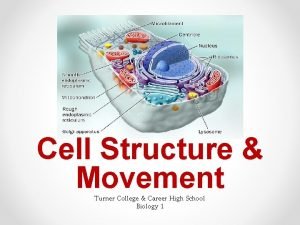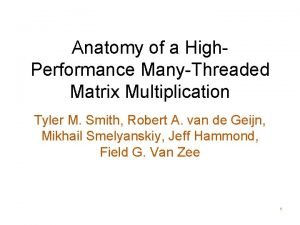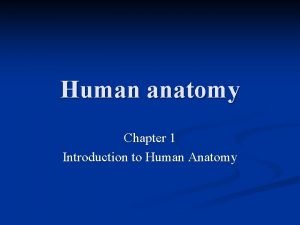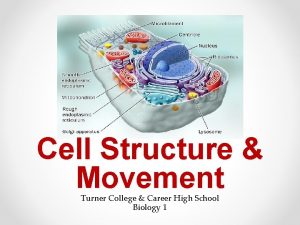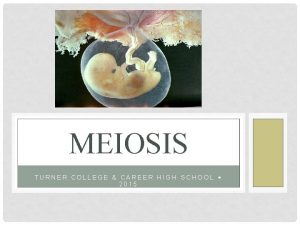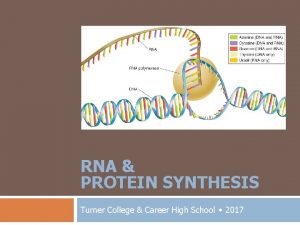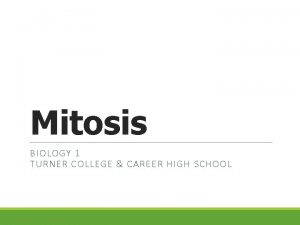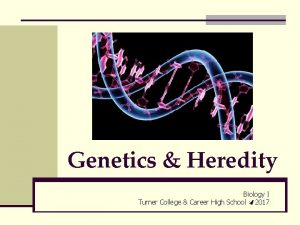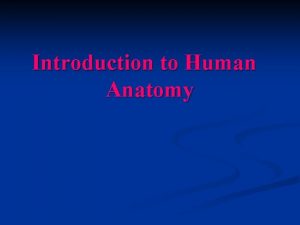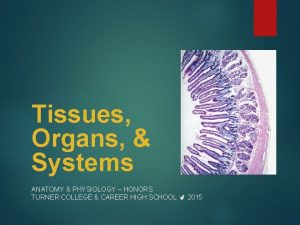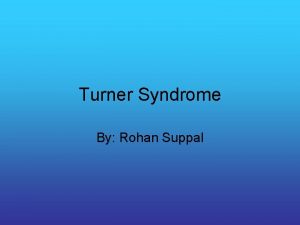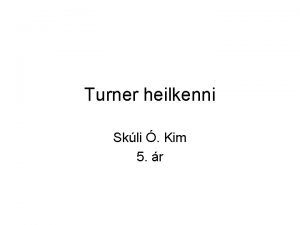INTRODUCTION TO HUMAN ANATOMY Turner College Career High





























- Slides: 29

INTRODUCTION TO HUMAN ANATOMY Turner College & Career High School

INTRODUCTIO N TO ANATOMY Illustrations in slides: © 2005 Pearson Education Inc. , publishing as Benjamin Cummings (unless otherwise indicated)

OVERVIEW OF ANATOMY Anatomical terminology from ancient Greek and Latin Branches of anatomy § Gross anatomy § Microscopic anatomy § Cytology § Histology § Developmental anatomy § Embryology § Comparative anatomy Hierarchy of structural organization from simplest to most complex Scale uses metric system

STRUCTURAL ORGANIZATION FROM SIMPLEST TO MOST COMPLEX Chemical Cellular Tissue – group of cells similar in structure and function Organ – two or more tissue types performing specific function Organ system – group of organs acting together to perform specific function Human organism

ORGAN SYSTEMS Integumentary Skeletal Muscular Nervous Endocrine Cardiovascular Lymphatic/immune Respiratory Digestive Urinary Reproductive

BRANCHES OF ANATOMY Gross anatomy Microscopic anatomy § Cytology § Histology Developmental anatomy § Embryology Comparative anatomy

THE HUMAN BODY PLAN Humans are vertebrates and share basic features § Tube-within-a-tube § Bilateral symmetry § Dorsal hollow nerve cord § Notochord and vertebrae § Segmentation § Pharyngeal pouches


BODY CAVITIES & MEMBRANES Dorsal cavity divided into cranial and vertebral Ventral cavity containing viscera (visceral organs) divided into two main cavities § Thoracic cavity § 2 lateral pleural cavities § Central mediastinum containing pericardial cavity § Abdominopelvic cavity § Abdominal cavity § Pelvic cavity Serous cavities are slit-like spaces lined by serous membranes (serosa): § Parietal serosa forms the outer wall of the cavity § Visceral serosa covers the visceral organ Other smaller cavities: in head, between joints


SEROSA

NAMING OF SEROUS MEMBRANES (SEROSA) WITH 2 ADJECTIVES: § Parietal serosa forms the outer wall of the cavity § Visceral serosa covers the visceral organ § Pericardial: heart § Pleural: lungs § Peritoneal: abdominal The 2 nd adjective can become a noun: pericardium, pleura, peritoneum

9 ABDOMINAL REGIONS; 4 QUADRANTS The important regions:

WHAT’S UNDERNEATH…

HISTOLOGY Microscopic examination of the fine structure of organs, tissues and cells Tissues are prepared by fixation (preserved) and then cut into thin sections Artifacts (distortions; not real)

CILIATED EPITHELIUM (a) 300 x (b) 1700 x (c) 2600 x

X-ray § Electromagnetic rays; denser tissues block more and are whiter (photographicall y they’re negatives)


Ultrasound § High frequency sound waves, like sonar

CT – Computed Tomography § a form of x-ray § provides a different form of imaging known as crosssectional imaging.

DSA – Digital Subtraction Angiography § A type of fluoroscopy technique used in interventional radiology to clearly visualize blood vessels in a bony or dense soft tissue environment.

PET scan – Positron Emission Tomography § A nuclear medicine, functional imaging technique that is used to observe metabolic processes in the body

MRI – Magnetic Resonance Imaging § A test that uses a magnetic field and pulses of radio wave energy to make pictures of organs and structures inside the body

TERMINOLOGY Study and memorize the Greek and Latin prefixes and suffixes: http: //www. technion. ac. il/~medicine/Students/latin&Greekprefi xes. html Many medical terms are built from Greek and Latin prefixes. Knowing the common words enables one to quickly comprehend and understand many long, complicated terms. Superficial Find definitions Deep and memorize terms: Anterior Posterior Superior Inferior Medial Lateral Proximal Distal Cephalic Vertebral Thoracic Appendicular Brachial Lumbar

Acro- extremity. Acrophobia is a fear of heights. Adeno- gland. Adenoid is a lymph gland found in the nasopharynx. Alba- white. Albinsm is the white appearance of skin lacking melanin. Algia- pain. Neuroalgia is a pain following the course of a nerve. Angi- vessel. Angioplasty is the repair of a blood vessel. Arthro- joint. Arthritis is the inflammation of skeletal joints. Auto- self. Autolysis is the destruction of body cells by bodily enzymes. Bio- living. Biology is the study of living organisms. Blast- germ, bud. Osteoblast is the germ of a bone cell. Blephar- eyelid. A blepharoplasty is eyelid surgery. Brachi- arm. The brachialis muscle moves the arm. Broncho- trachea, windpipe. Bronchitis is the inflammation of the respiratory system. Bucc- cheek. The buccinator muscle is in the cheek. Capit- head. De-capitate means "Off With the Head!“ Carcin- cancer. A carcinogen is a substance which triggers cancer formation. Cardia- heart. Cardiologist is a heart specialist. Cephal- head. Cephalon is another term for the brain. (see capit-) Cerebro- brain. Cerebrospinal fluid (CSF) is fluid circulating within the brain and spinal cord. Chole- bile, gall. Cholecestectomy is removal of the gallbladder. Chondro- cartilage. A chondrocyte is a cartilage cell.

Chroma- color. Chromosomes are so named because they took color easily when dye is added to a cell. Cili- eyelash. Supercilia are eyebrows -- the hairs above the eyelashes. Corpus- body. Corpus albicans is the white body inside an ovary. Corona Crown. Coronary arteries supply blood to the heart muscle run along the heart, encircling it like a crown. The coronary ligaments of the liver (which encircle the liver like a crown), the coronal suture and the corona of the glans penis, all structures which encircle something (like a crown). Cost- rib. Costal cartilages attach ribs to the sternum. Cut- skin. Cutaneous tissue is skin tissue. Cysti- sac, bladder. Cyto- cell. Cytology is the study of cells. Dactyl- digits. Polydactylism is the presence of more fingers than is normal. Derma- skin. Dermatologists are skin specialists. Dura- tough, hard. Dura mater is the tough covering around the brain and spinal cord. Entero- intestine. Enteritis is inflammation of the intestines. Erythro- red. Erythrocytes are red blood cells. Galacto- milk. Galactose-Milk Sugur; Galactosemia is the lack of ability to digest one of milk's sugars. Gastro- stomach, belly. Gastric juices are produced in the stomach.

Glosso- tongue. Hypoglossal means "below the tongue". Glyco- sugar. Glycosuria is sugar in the urine. Hema- blood. Hemaglobin is a large molecule of the red blood cell. Hepato- liver. The hepatic vein drains blood away from the liver. Hyster- uterus. Hysterectomy is the removal of the uterus. Ileo- ileum. Part of the small intestine. Ilio- ilium. Part of the hip bone. Lachry- tears. Lacrimal glands secrete tears. Leuko- white. Leukocytes are white cells of the blood. (see alba-) Lingua- tongue. Sublingual glands are beneath the tongue. (see glosso-) Lipo- fat. Liposuction is the removal of fat by suction tube. Lith- stone. Shock wave lithotripsy is a treatment for breaking up kidney stones. Lumbo- lower back. Lumbar vertebrae are located in the lower back. Macul- spot, blotch. The macula lutea is a spot on the retina of an eyeball. Mamm- breast. Mammogram is a picture of a breast, usually a female breast. Mast- breast. Aren't we showing our obsession with breasts? Meningo- membrane. Meninges are the coverings of the brain and spinal

Morpho- shape. Endomorphs are people whose physical shape extends to the limits of human dimension. Myelo- spinal cord. Poliomyelitis is inflammation of the grey matter of the spinal cord. Myo- muscle. Myo-cardiac infarction is a problem with the heart muscle. Necro- death. Necrosis is death of cell tissue. Nephro- kidney. Nephrons are the functional units of a kidney. Neuro- nerve. Neurons are individual nerve cells. Oculo- eye. An oculist supplies eyeglasses. Odont- tooth. Othodontics refers to repair of teeth. Onco- tumour. Oncology is not doctors wearing pagers; it is the study of cancerous tumors. Ophthalm- eye. Ophthalmology is the study of eye and its diseases. Oro- mouth. The oral cavity is the other name for the mouth. Orchido- testicle. Orchidectomy is removal of a testicle. Osse-, Osteo- bone. Osteoporosis is porosity of bone. Oto- ear. Otosclerosis is the formation of bone in the ear. Otomycosisfungal infection in ear Patho- disease. Pathogens are agents which cause disease. Peps- digestion. Pepsin is an enzyme found in the digestive system. Phago- eat. Phagocytes are cells (cyto-) which eat foreign material. Philo- love, to have an affinity for. Hydrophilic molecules are attracted to water (hydro-)

Phren- diaphragm. Phrenic refers to a diaphragm. Pneumo- lung. Pneumonia is a disease of the lungs. Pulmo- lung. Are lungs related to breasts? Pyo- pus. Pyruria is pus in the urine. Ren- kidney. Renal artery supplies blood to the kidney. Rhin- nose. Rhinoplasty is a nose job Scler- hard. Atherosclerosis is hardening of the arteries. (see dura-) Stasis- stand still. Homeostasis is the process of maintaining constant conditions within the body. Thromb- clot, lump. Thrombosis refers to a clot in the heart or blood vessel. Trich- hair. Trichosis is a disease of the hair. Vas- vessel, duct. Vas deferens is the vessel which carries sperm from the epididymus. Viscer- organ. Visceral refers to organs. Zoo- animal. Zoology refers to the study of animals.
 Infinite campus perth amboy
Infinite campus perth amboy Turner college and career high school
Turner college and career high school Early college high school at midland college
Early college high school at midland college Chapter 1 introduction to human anatomy and physiology
Chapter 1 introduction to human anatomy and physiology Medial and lateral
Medial and lateral 16 national career clusters
16 national career clusters Formulas for career success: résumés - assessment
Formulas for career success: résumés - assessment Cccframework
Cccframework Reading inventory score chart
Reading inventory score chart College lexile
College lexile Vocabulary power plus for college and career readiness
Vocabulary power plus for college and career readiness Northwest career college
Northwest career college Fleming college jobs
Fleming college jobs College and career readiness standards math
College and career readiness standards math American career college optimal resume
American career college optimal resume Theodore roosevelt college and career academy
Theodore roosevelt college and career academy Cpcc academic calendar
Cpcc academic calendar Occu find and fyi access code
Occu find and fyi access code Asvab career exploration program for high school students
Asvab career exploration program for high school students Career prep high school shiprock
Career prep high school shiprock Career orientation program for high school students
Career orientation program for high school students Anatomy of high-performance matrix multiplication
Anatomy of high-performance matrix multiplication Career development introduction
Career development introduction Stem career cluster vocabulary
Stem career cluster vocabulary 3 layers of muscle
3 layers of muscle Dorsal and ventral side
Dorsal and ventral side Human anatomy vocabulary
Human anatomy vocabulary Holes essential of human anatomy and physiology
Holes essential of human anatomy and physiology Figure 16-5 is a sagittal view of the female
Figure 16-5 is a sagittal view of the female The right hypochondriac region is in the ruq
The right hypochondriac region is in the ruq

